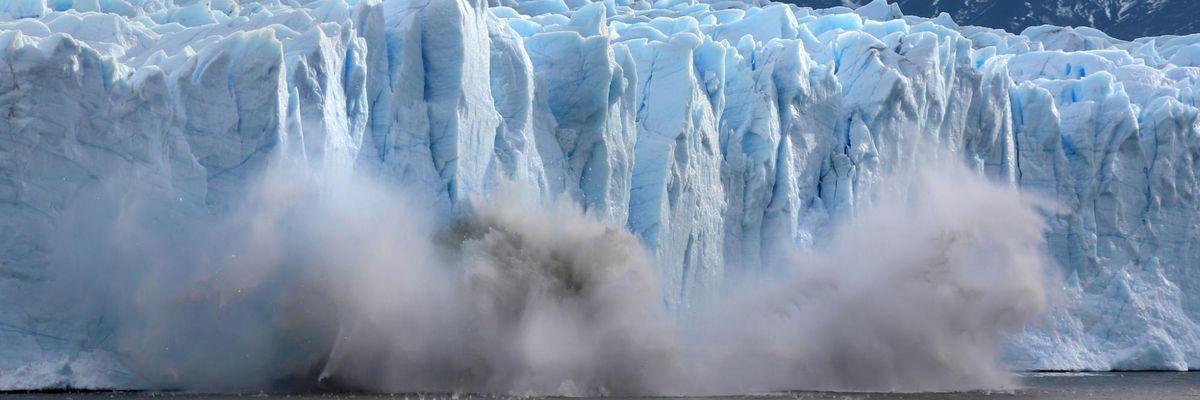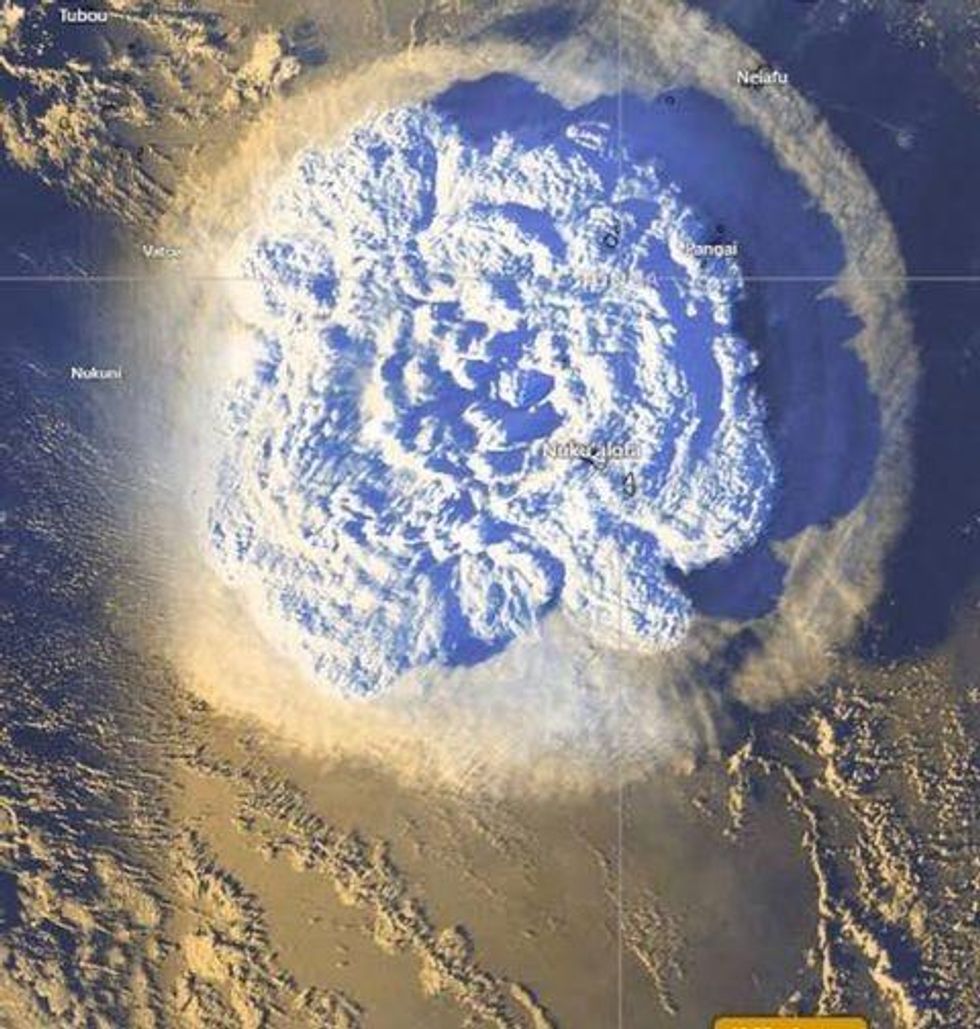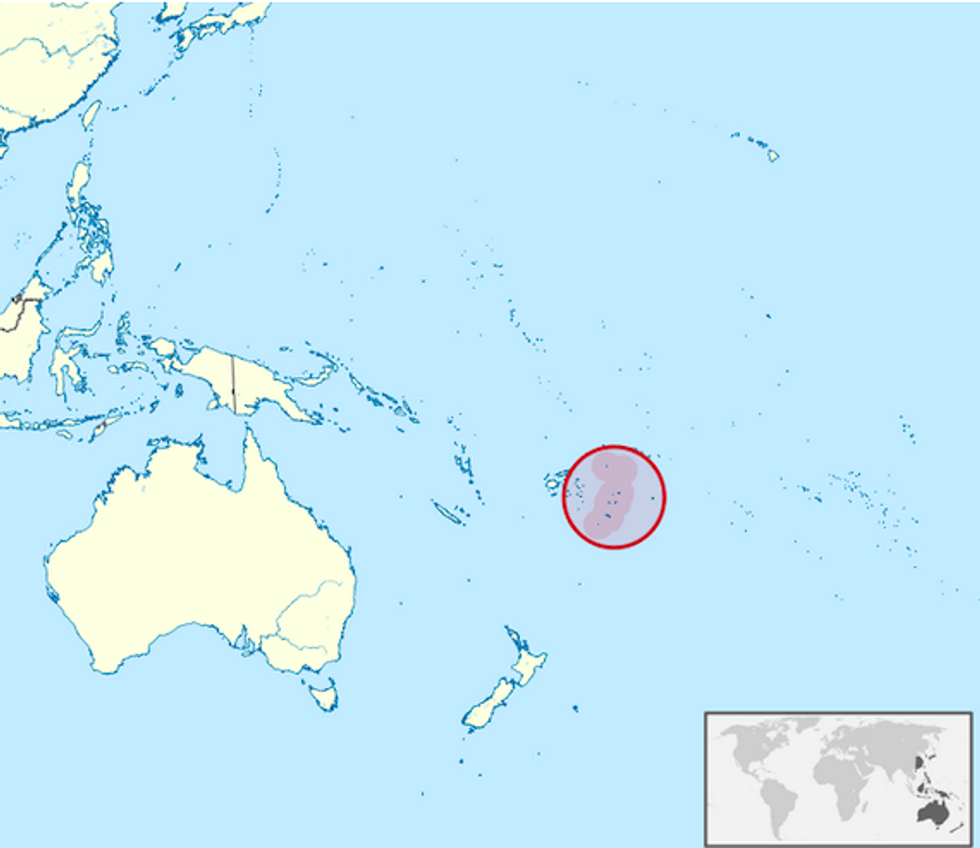

SUBSCRIBE TO OUR FREE NEWSLETTER
Daily news & progressive opinion—funded by the people, not the corporations—delivered straight to your inbox.
5
#000000
#FFFFFF
To donate by check, phone, or other method, see our More Ways to Give page.


Daily news & progressive opinion—funded by the people, not the corporations—delivered straight to your inbox.

A piece of the Perito Moreno glacier, part of the Southern Patagonian Ice Field, breaks off and crashes into Lake Argentina in the Los Glaciares National Park on April 5, 2019 in Santa Cruz province, Argentina. (Photo: David Silverman via Getty Images)
A massive eruption in an undersea volcano, the Hunga Tonga-Hunga Ha'apai, 40 miles north of the South Pacific island of Tongatapu on Saturday caused a low-level tsunami and flooding on the island, the most populous in the Tonga archipelago. The tsunami spread out from there, causing one- to three-foot waves in Hawaii and some one-foot waves on the West Coast of the US and down to Chile. The waves created rip tides that endangered marinas and swimmers. Further eruptions cannot be ruled out.
At the moment, most volcanic eruptions are not related to the climate emergency, but events like this give us a taste of what will begin happening regularly if large Antarctic glaciers begin plopping into the ocean because of the coal and gasoline we burn daily. In fact, some of those glaciers could raise sea levels as much as six feet all by themselves, so their effects would be much worse. Some scientists believe that the Thwaite "doomsday glacier" could break up within only ten years.
Moreover, as the world's surface ice melts and the oceans rise, that will put more pressure on the earth's crust, so we will see increased vulcanism, and more tsunamis. So get used to it.
\u201cOne of the impacts of climate change is increased volcanism, earthquakes & tsunamis -- as massive amounts of ice melt, the pressures on magma chambers and tectonic plates shift and ease, destabilizing them.\n\nhttps://t.co/l3R3xYCMnr\u201d— Prof. Eliot Jacobson (@Prof. Eliot Jacobson) 1642255207
The earth is capable of intense fury that can sweep everything along in its path, and our burning of fossil fuels and putting billions of tons of heat-trapping gases into the atmosphere are infuriating the earth
New Zealand Prime Minister Jacinda Ardern posted this photo of this behemoth of an eruption on her Facebook page:

The volcano threw up an ash cloud to 63,000 feet, higher than New Zealand aircraft could fly, and so prevented aerial reconnaissance.
Three-foot waves slammed into the coast at the Kingdom of Tonga's capital city, Nuku`alofa, depositing boulders and ships and damaging shops. The king had to be evacuated from his palace on Tongatapu, the island on which 70 percent of Tongans live.
Tongans in New Zealand who were able to get in cell phone contact with family members in the islands reported that much of Nuku'alofa was under water.
A layer of ash nearly an inch thick was deposited some places, endangering fresh water sources and air quality An undersea cable stopped working, possibly because of a loss of electricity, and the situation on the Tonga islands is a little unclear. Some photos of flood damage have been sent to the outside world, though:
\u201cThis is incredibly sad. The damage being done to the Kingdom of #Tonga is extreme. The people of Kingdom are strong. Sending prayers to\ud83c\uddf9\ud83c\uddf4. Ofa lahi atu. \ud83c\uddf9\ud83c\uddf4 \ud83d\udc94\ud83d\ude4f\u201d— Consulate of the Kingdom of Tonga (@Consulate of the Kingdom of Tonga) 1642276815

Tonga in S. Pacific (h/t Wikimedia).
The Kingdom of Tonga has a population of about 104,000, spread over 36 inhabited islands in the archipelago, of which 70 percent live on the main island of Tongatapu. It is the site of the capital, Nuku'alofa, which reportedly has suffered heavy flooding as well as ash deposits. Sea level rise because of human CO2 emissions and consequent global heating threatens to submerge many South Pacific islands.
Dear Common Dreams reader, The U.S. is on a fast track to authoritarianism like nothing I've ever seen. Meanwhile, corporate news outlets are utterly capitulating to Trump, twisting their coverage to avoid drawing his ire while lining up to stuff cash in his pockets. That's why I believe that Common Dreams is doing the best and most consequential reporting that we've ever done. Our small but mighty team is a progressive reporting powerhouse, covering the news every day that the corporate media never will. Our mission has always been simple: To inform. To inspire. And to ignite change for the common good. Now here's the key piece that I want all our readers to understand: None of this would be possible without your financial support. That's not just some fundraising cliche. It's the absolute and literal truth. We don't accept corporate advertising and never will. We don't have a paywall because we don't think people should be blocked from critical news based on their ability to pay. Everything we do is funded by the donations of readers like you. Will you donate now to help power the nonprofit, independent reporting of Common Dreams? Thank you for being a vital member of our community. Together, we can keep independent journalism alive when it’s needed most. - Craig Brown, Co-founder |
A massive eruption in an undersea volcano, the Hunga Tonga-Hunga Ha'apai, 40 miles north of the South Pacific island of Tongatapu on Saturday caused a low-level tsunami and flooding on the island, the most populous in the Tonga archipelago. The tsunami spread out from there, causing one- to three-foot waves in Hawaii and some one-foot waves on the West Coast of the US and down to Chile. The waves created rip tides that endangered marinas and swimmers. Further eruptions cannot be ruled out.
At the moment, most volcanic eruptions are not related to the climate emergency, but events like this give us a taste of what will begin happening regularly if large Antarctic glaciers begin plopping into the ocean because of the coal and gasoline we burn daily. In fact, some of those glaciers could raise sea levels as much as six feet all by themselves, so their effects would be much worse. Some scientists believe that the Thwaite "doomsday glacier" could break up within only ten years.
Moreover, as the world's surface ice melts and the oceans rise, that will put more pressure on the earth's crust, so we will see increased vulcanism, and more tsunamis. So get used to it.
\u201cOne of the impacts of climate change is increased volcanism, earthquakes & tsunamis -- as massive amounts of ice melt, the pressures on magma chambers and tectonic plates shift and ease, destabilizing them.\n\nhttps://t.co/l3R3xYCMnr\u201d— Prof. Eliot Jacobson (@Prof. Eliot Jacobson) 1642255207
The earth is capable of intense fury that can sweep everything along in its path, and our burning of fossil fuels and putting billions of tons of heat-trapping gases into the atmosphere are infuriating the earth
New Zealand Prime Minister Jacinda Ardern posted this photo of this behemoth of an eruption on her Facebook page:

The volcano threw up an ash cloud to 63,000 feet, higher than New Zealand aircraft could fly, and so prevented aerial reconnaissance.
Three-foot waves slammed into the coast at the Kingdom of Tonga's capital city, Nuku`alofa, depositing boulders and ships and damaging shops. The king had to be evacuated from his palace on Tongatapu, the island on which 70 percent of Tongans live.
Tongans in New Zealand who were able to get in cell phone contact with family members in the islands reported that much of Nuku'alofa was under water.
A layer of ash nearly an inch thick was deposited some places, endangering fresh water sources and air quality An undersea cable stopped working, possibly because of a loss of electricity, and the situation on the Tonga islands is a little unclear. Some photos of flood damage have been sent to the outside world, though:
\u201cThis is incredibly sad. The damage being done to the Kingdom of #Tonga is extreme. The people of Kingdom are strong. Sending prayers to\ud83c\uddf9\ud83c\uddf4. Ofa lahi atu. \ud83c\uddf9\ud83c\uddf4 \ud83d\udc94\ud83d\ude4f\u201d— Consulate of the Kingdom of Tonga (@Consulate of the Kingdom of Tonga) 1642276815

Tonga in S. Pacific (h/t Wikimedia).
The Kingdom of Tonga has a population of about 104,000, spread over 36 inhabited islands in the archipelago, of which 70 percent live on the main island of Tongatapu. It is the site of the capital, Nuku'alofa, which reportedly has suffered heavy flooding as well as ash deposits. Sea level rise because of human CO2 emissions and consequent global heating threatens to submerge many South Pacific islands.
A massive eruption in an undersea volcano, the Hunga Tonga-Hunga Ha'apai, 40 miles north of the South Pacific island of Tongatapu on Saturday caused a low-level tsunami and flooding on the island, the most populous in the Tonga archipelago. The tsunami spread out from there, causing one- to three-foot waves in Hawaii and some one-foot waves on the West Coast of the US and down to Chile. The waves created rip tides that endangered marinas and swimmers. Further eruptions cannot be ruled out.
At the moment, most volcanic eruptions are not related to the climate emergency, but events like this give us a taste of what will begin happening regularly if large Antarctic glaciers begin plopping into the ocean because of the coal and gasoline we burn daily. In fact, some of those glaciers could raise sea levels as much as six feet all by themselves, so their effects would be much worse. Some scientists believe that the Thwaite "doomsday glacier" could break up within only ten years.
Moreover, as the world's surface ice melts and the oceans rise, that will put more pressure on the earth's crust, so we will see increased vulcanism, and more tsunamis. So get used to it.
\u201cOne of the impacts of climate change is increased volcanism, earthquakes & tsunamis -- as massive amounts of ice melt, the pressures on magma chambers and tectonic plates shift and ease, destabilizing them.\n\nhttps://t.co/l3R3xYCMnr\u201d— Prof. Eliot Jacobson (@Prof. Eliot Jacobson) 1642255207
The earth is capable of intense fury that can sweep everything along in its path, and our burning of fossil fuels and putting billions of tons of heat-trapping gases into the atmosphere are infuriating the earth
New Zealand Prime Minister Jacinda Ardern posted this photo of this behemoth of an eruption on her Facebook page:

The volcano threw up an ash cloud to 63,000 feet, higher than New Zealand aircraft could fly, and so prevented aerial reconnaissance.
Three-foot waves slammed into the coast at the Kingdom of Tonga's capital city, Nuku`alofa, depositing boulders and ships and damaging shops. The king had to be evacuated from his palace on Tongatapu, the island on which 70 percent of Tongans live.
Tongans in New Zealand who were able to get in cell phone contact with family members in the islands reported that much of Nuku'alofa was under water.
A layer of ash nearly an inch thick was deposited some places, endangering fresh water sources and air quality An undersea cable stopped working, possibly because of a loss of electricity, and the situation on the Tonga islands is a little unclear. Some photos of flood damage have been sent to the outside world, though:
\u201cThis is incredibly sad. The damage being done to the Kingdom of #Tonga is extreme. The people of Kingdom are strong. Sending prayers to\ud83c\uddf9\ud83c\uddf4. Ofa lahi atu. \ud83c\uddf9\ud83c\uddf4 \ud83d\udc94\ud83d\ude4f\u201d— Consulate of the Kingdom of Tonga (@Consulate of the Kingdom of Tonga) 1642276815

Tonga in S. Pacific (h/t Wikimedia).
The Kingdom of Tonga has a population of about 104,000, spread over 36 inhabited islands in the archipelago, of which 70 percent live on the main island of Tongatapu. It is the site of the capital, Nuku'alofa, which reportedly has suffered heavy flooding as well as ash deposits. Sea level rise because of human CO2 emissions and consequent global heating threatens to submerge many South Pacific islands.